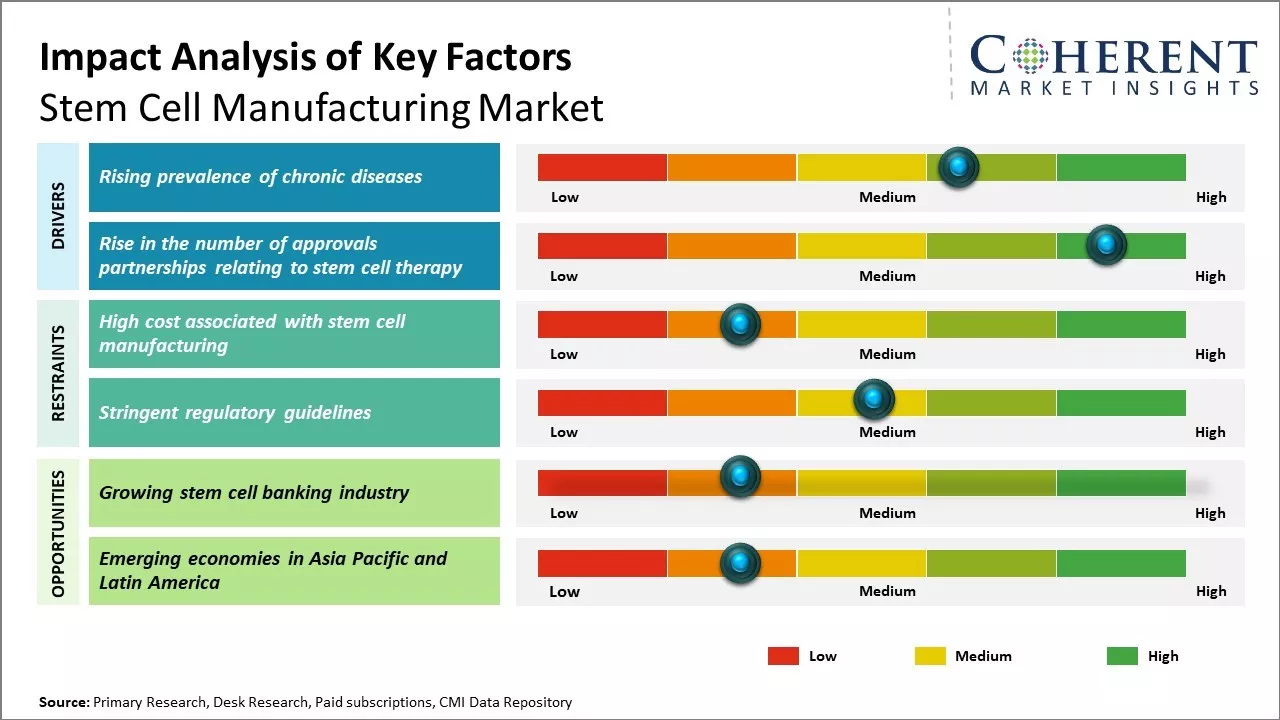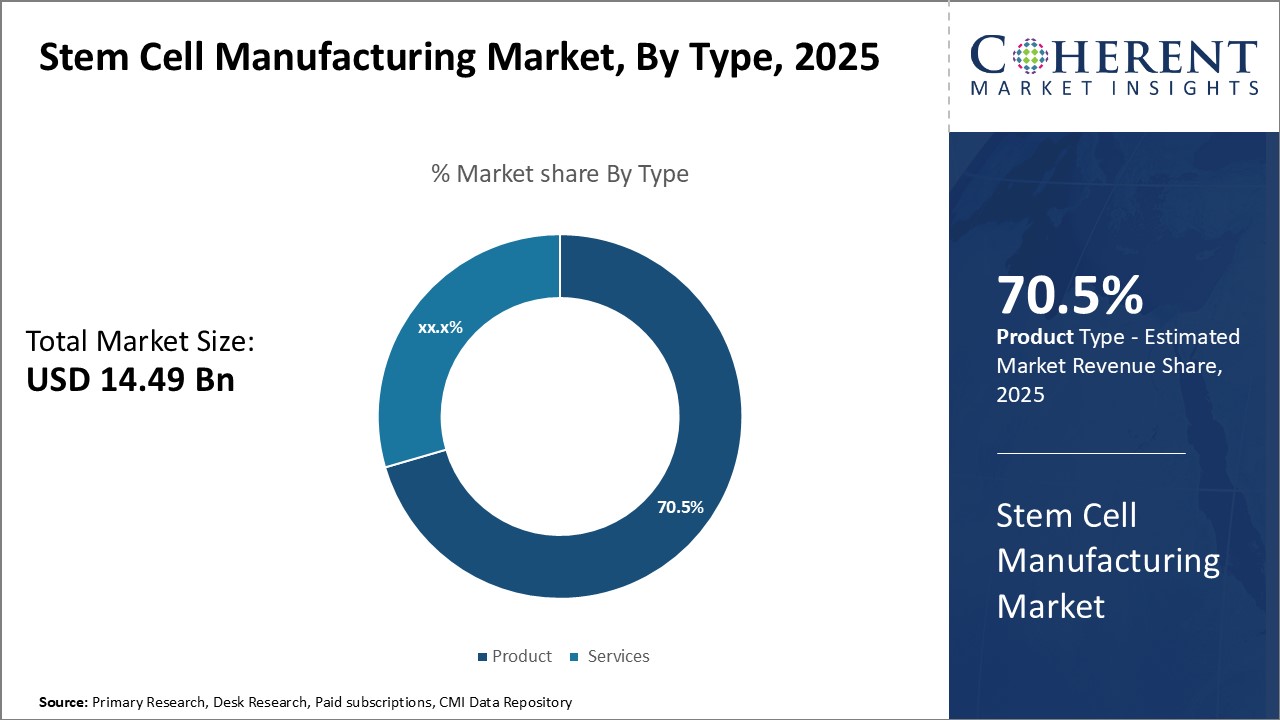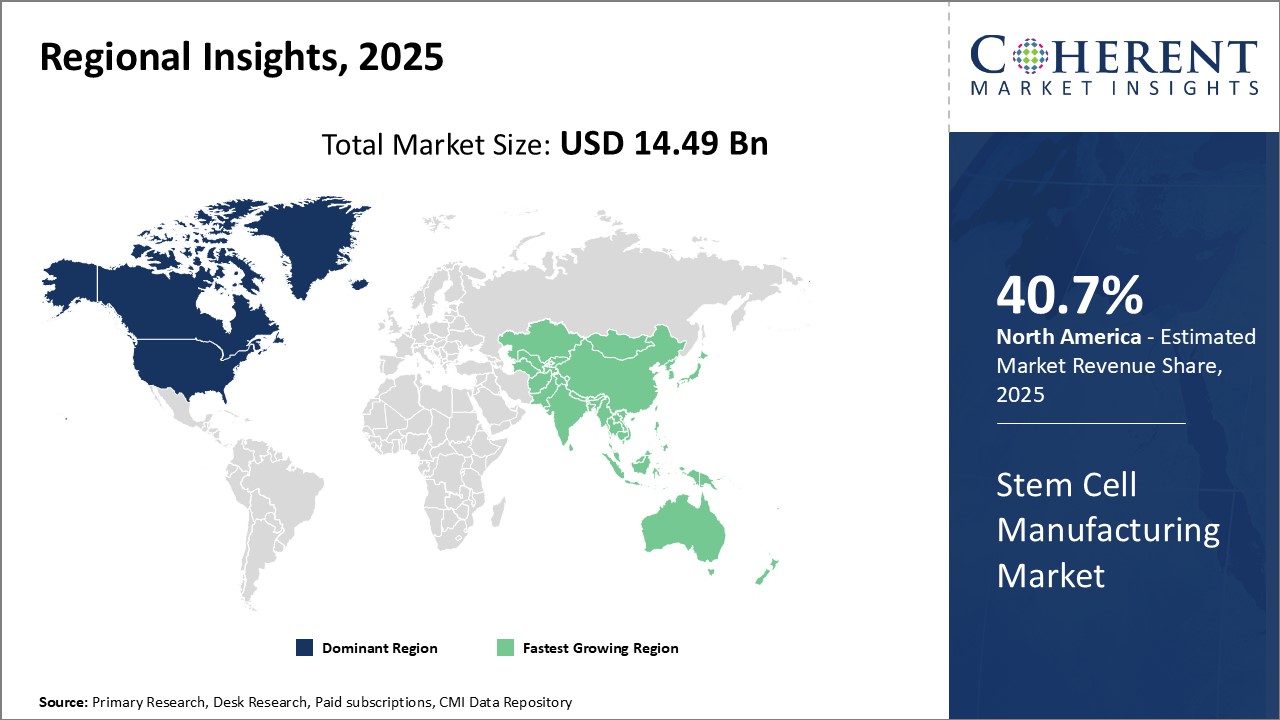Global Stem Cell Manufacturing market is estimated to be valued at USD 14.49 Bn in 2025 and is expected to reach USD 34.54 Bn by 2032, exhibiting a compound annual growth rate (CAGR) of 13.2% from 2025 to 2032.

Discover market dynamics shaping the industry: Download Free Sample
The market is driven by factors such as rising prevalence of chronic diseases, growing R&D in drug discovery and regenerative medicine, and increasing investments in stem cell research. The stem cell manufacturing market trend involves adoption of automation and closed system process technologies to develop advanced stem cell therapeutics. As stem cell therapy becomes applicable across various clinical indications, market players are focusing on enhancing stem cell culture, isolation, and cryopreservation techniques. Additionally, the integration of continuous manufacturing with digitization presents lucrative opportunities for stem cell therapy commercialization in the coming years. For instance, In January 2025, according to a study published in the Journal of the American Heart Association found that the global prevalence of heart failure reached 56.19 million cases, highlighting the increasing burden of chronic cardiovascular diseases
Rising prevalence of chronic diseases
The global burden of chronic diseases has been steadily increasing over the past few decades. Chronic diseases such as cancer, cardiac ailments, diabetes, neurological disorders have become major public health challenges across both developed and developing world. The global stem cell manufacturing market is projected to expand due to the increasing prevalence of chronic and neurological disorders. Stem cells offer potential for replacing damaged neurons caused by conditions like spinal cord injuries, Parkinson’s disease, and Alzheimer's disease. Stem cell therapy presents a viable option for treating Parkinson's disease, which has seen a doubling in global prevalence over the past 25 years, with more than 8.5 million individuals affected as of 2020, For Instance according to the World Health Organization (WHO)In February 2020, Rising awareness of the therapeutic potential of stem cells is anticipated to drive market growth. Stem cells are now routinely utilized by doctors in treating cancer and various blood and immune system disorders. WHO reports that cancer remains a leading cause of death worldwide, claiming nearly 10 million lives in 2020, representing nearly one in six deaths. Breast, lung, colon and rectum, and prostate cancers are among the most common types. Consequently, market players are focusing on introducing novel stem cell therapies for cancer treatment.

Get actionable strategies to beat competition: Download Free Sample
Rise in the number of approvals partnerships relating to stem cell therapy
The market is anticipated to experience growth driven by an increase in approvals and partnerships related to stem cell therapy. For instance, in March 2021, Vertex Pharmaceuticals obtained FDA fast-track designation for VX-880, a human stem cell-derived therapy intended for patients with Type 1 diabetes. VX-880 represents a pioneering allogeneic, fully differentiated islet cell therapy aimed at regulating glucose levels by reinstating pancreatic islet cell function, including insulin production.
Key Takeaways from Analyst
The global stem cell manufacturing market is expected experience significant growth in the coming years. Significant advancements in stem cell therapy research and clinical trials is a major driver as it is increasing the application of stem cells in various disease treatments. Growing prevalence of chronic diseases such as cancer, diabetes is also boosting demand.
North America currently dominates the market and is expected to continue its leadership supported by ongoing research investments and new clinical trials. However, Asia Pacific is poised to be the fastest growing market with growth rates exceedingly more than 10% annually. Countries like China, India, Japan and South Korea are investing aggressively in building state-of-the-art stem cell banks and GMP approved manufacturing facilities.
While the market outlook remains bullish, there are a few challenges. High infrastructure and equipment costs for stem cell manufacturing poses a restraint. Stringent regulatory approvals and ethical concerns also hampers market potential. Lack of acceptance and awareness in developing nations curbs market penetration. To leverage opportunities, partnerships between industry and academic institutes, expanded clinical applications and collaborations between stem cell companies especially across Asia and North America will be crucial. Emergence of induced pluripotent stem cells will disrupt the market and reduce reliance on embryonic stem cells over time.
Market Challenges: High cost associated with stem cell manufacturing
The global stem cell manufacturing market's growth is likely to be impeded by the high costs associated with stem cell production. Despite the significant contributions of stem cell therapies to the treatment of incurable diseases, the expense of manufacturing stem cells poses a challenge to market expansion. Furthermore, socio-ethical concerns surrounding the use of human embryonic stem cells are expected to restrict the growth of the global stem cell manufacturing market. For instance, according to article provided by ScienceDirect in October 2020 research involving human embryonic stem cells is a subject of ethical and political controversy due to the destruction of human embryos. In the United States, the contentious issue of when human life begins is closely intertwined with the abortion debate.
Market Opportunities: Growing stem cell banking industry
The growing stem cell banking industry provides a great opportunity for growth in the stem cell manufacturing market. As more parents opt to store umbilical cord blood stem cells for potential future medical use, the demand for stem cell storage and processing is accelerating. According to the World Marrow Donor Association, over 30 million stem cell units have been collected worldwide in 2020. This stored biomass of stem cells will need to be safely processed and manufactured into various therapies as medical research continues to develop new treatment protocols.
For Instance, according to an article published in PubMed in September 2022, stem cell therapy, supported by both in vitro and in vivo studies, demonstrates safety and effectiveness in treating a range of diseases. Stem cell treatment aims to repair or restore damaged organs and congenital abnormalities utilizing human stem cells, including embryonic stem cells (ESCs), adult stem cells (ASCs), and induced pluripotent stem cells (iPSCs).

Discover high revenue pocket segments and roadmap to it: Download Free Sample
Insights, By Type: Scale and Quality Drive Product Segment Share
In terms of By Type, Product contributes the highest share of the global stem cell manufacturing market with 70.5% in 2025 owing to the need for standardized and reliable cellular material. Companies focused on developing stem cell therapies, drugs, and banking rely on consistent and high-quality stem cell supply to power their research and applications. The product segment provides standardized stem cell lines, media, reagents, and more to facilitate research activities. Universities and biopharmaceutical organizations leverage commercial stem cell products to shortcut lengthy in-house process development and optimize efficiency. Ensuring reproducible quality across studies and trials requires sourcing validated materials. As stem cell science advances into more complex applications and clinical use, demand will grow for off-the-shelf, scalable stem cell manufacturing solutions. Streamlined access to safe, well-characterized stem cell production components through the product segment supports the expansion of the entire industry.
Insights, By Application: Medical Innovation Fuels Stem Cell Therapy Dominance
In terms of By Application, Stem Cell Therapy contributes the highest share with 40.1 % in 2025 owing to active progress in translating potential into patient care. Conditions such as cardiovascular disease, inflammatory disorders, neurological conditions, and more have shown response to stem cell treatments in clinical and preclinical research. As the first commercial stem cell therapies receive approval and demonstration of efficacy accumulates, interest among patients, providers and investors rises accordingly. Medical advances like using mesenchymal stem cells as anti-inflammatories or directing stem cell differentiation for targeted tissue regeneration drive therapeutic innovation. The application segment also gains from positive publicity surrounding high-profile treatment efforts. Larger pharmaceutical players entering the field through partnership and acquisition extend the industrial backing behind therapy development. Widening applicability for stem cell medicine ensures the therapy segment sustains lead market position as new indications find resolution. For Instance, In September 2022 article published in PubMed indicates that stem cell therapy, supported by both in vitro and in vivo studies, demonstrates safety and effectiveness in treating a range of diseases. Stem cell treatment aims to rejuvenate or mend impaired organs and congenital abnormalities by employing human stem cells like embryonic stem cells (ESCs), adult stem cells (ASCs), and induced pluripotent stem cells (iPSCs).
Insights, Academia Catalyzes via Discovery, Biopharma Scales through Partnership
In terms of By End User, Biopharmaceutical companies and CRO contributes the highest share with 39 % in 2025 due to leveraging partnership advantages. Academic centers pioneer early stem cell research, gaining knowledge that requires industrial expertise to deliver. Biopharmaceutical organizations collaborate with researchers to accelerate translational cycles as they commit funding, project management skills and strategic production capabilities. Through contract work facilitating academic investigations or ecodevelopment of intellectual property, CROs similarly bridge university creativity and private sector scale-up needs. Biopharma end users disseminate tools arising from stem cell science through commercialized therapies, diagnostics and procedures. Joint industry-academic ventures increase each sector's capabilities by combining investigative foundation with mass production and global market distribution competencies. Ensuring a balanced public-private research ecosystem generates most efficient pathways to realizing stem cell technology applications and socioeconomic benefits.

Need a Different Region or Segment? Download Free Sample
North America has established itself as the dominant region in the global stem cell manufacturing market with share of 40.7% in 2025. The U.S. alone accounts for over 50.5% of the total market share, attributed to heavy investments in R&D by both government and private players. Countries in the region have highly evolved healthcare systems compared to others globally, which has facilitated increased adoption of advanced therapeutics, including those derived from stem cells. The presence of top research universities and major biopharma companies has created a robust stem cell manufacturing ecosystem in North America. for instance, in April 2022, the Stem Cell Network (SCN) of Canada unveiled IGNITE 2022-2025, a three-year strategic blueprint funded by the Government of Canada through a USD 45 million allocation in Budget 2021. This initiative, IGNITE 2022-2025, is structured around three fundamental pillars: research, training, and knowledge dissemination. Each of these pillars plays a crucial role in positioning Canadian scientists and expertise at the forefront of global regenerative medicine (RM) endeavors.
Asia Pacific has emerged as the fastest growing regional market in recent times, primarily due to focus of countries like China, Japan, South Korea and India towards building healthcare infrastructure and stem cell research capabilities. China especially has aggressively pushed policies to drive innovative stem cell therapies development. This coupled with preference of large biopharma’s to establish facilities in Asia due to relatively lower costs and availability of skilled workforce, have positioned the region as an important player.
Stem Cell Manufacturing Market Report Coverage
| Report Coverage | Details | ||
|---|---|---|---|
| Base Year: | 2024 | Market Size in 2025: | USD 14.49 Bn |
| Historical Data for: | 2020 To 2024 | Forecast Period: | 2025 To 2032 |
| Forecast Period 2025 to 2032 CAGR: | 13.2% | 2032 Value Projection: | USD 34.54 Bn |
| Geographies covered: |
|
||
| Segments covered: |
|
||
| Companies covered: |
Sartorius, Becton, Dickinson and Company, Fujifilm Holdings Corporation, Lonza Group, Stemcell Technologies, Corning Incorporated, Merck Group, Thermo Fisher Scientific, Pluristem Therapeutics Inc., Miltenyi Biotec, Takeda Pharmaceutical Company Limited, DAIICHI SANKYO COMPANY, LIMITED, AbbVie Inc., Bristol-Myers Squibb Company, GlaxoSmithKline Plc, Danaher Corporation, Accegen, Cellular Engineering Technologies |
||
| Growth Drivers: |
|
||
| Restraints & Challenges: |
|
||
Uncover macros and micros vetted on 75+ parameters: Get instant access to report
Share
Share
About Author
Nikhilesh Ravindra Patel is a Senior Consultant with over 8 years of consulting experience. He excels in market estimations, market insights, and identifying trends and opportunities. His deep understanding of the market dynamics and ability to pinpoint growth areas make him an invaluable asset in guiding clients toward informed business decisions. He plays a instrumental role in providing market intelligence, business intelligence, and competitive intelligence services through the reports.
Missing comfort of reading report in your local language? Find your preferred language :
Transform your Strategy with Exclusive Trending Reports :
Frequently Asked Questions
Joining thousands of companies around the world committed to making the Excellent Business Solutions.
View All Our Clients